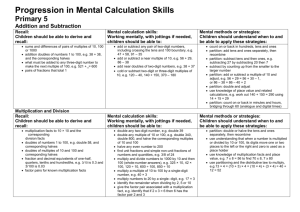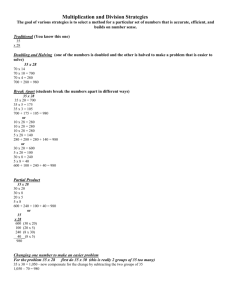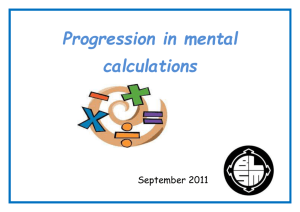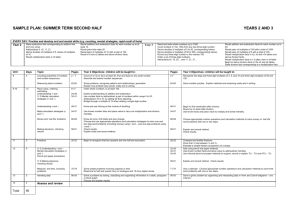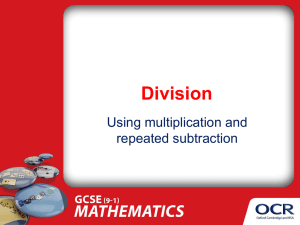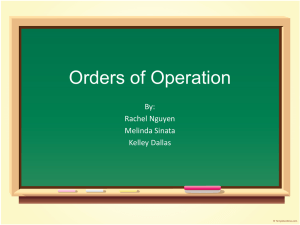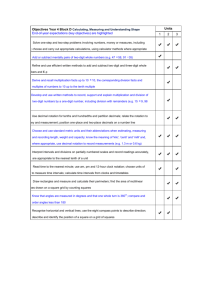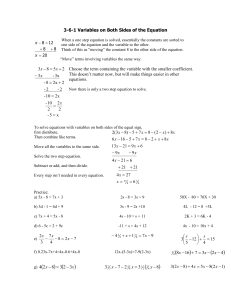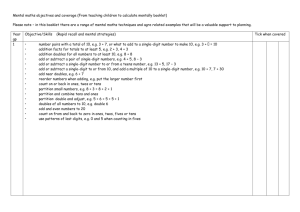Mental calculation: expectations for each year
advertisement
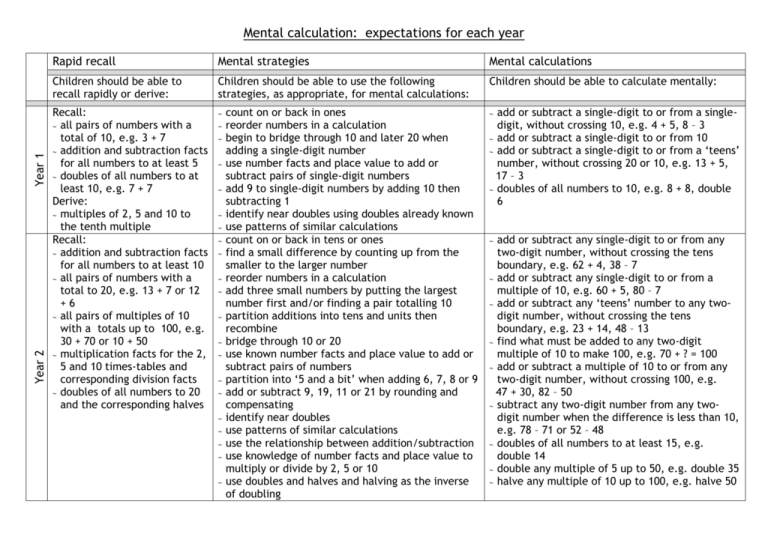
Year 2 Year 1 Mental calculation: expectations for each year Rapid recall Mental strategies Mental calculations Children should be able to recall rapidly or derive: Children should be able to use the following strategies, as appropriate, for mental calculations: Children should be able to calculate mentally: Recall: all pairs of numbers with a total of 10, e.g. 3 + 7 addition and subtraction facts for all numbers to at least 5 doubles of all numbers to at least 10, e.g. 7 + 7 Derive: multiples of 2, 5 and 10 to the tenth multiple Recall: addition and subtraction facts for all numbers to at least 10 all pairs of numbers with a total to 20, e.g. 13 + 7 or 12 +6 all pairs of multiples of 10 with a totals up to 100, e.g. 30 + 70 or 10 + 50 multiplication facts for the 2, 5 and 10 times-tables and corresponding division facts doubles of all numbers to 20 and the corresponding halves count on or back in ones reorder numbers in a calculation begin to bridge through 10 and later 20 when adding a single-digit number use number facts and place value to add or subtract pairs of single-digit numbers add 9 to single-digit numbers by adding 10 then subtracting 1 identify near doubles using doubles already known use patterns of similar calculations count on or back in tens or ones find a small difference by counting up from the smaller to the larger number reorder numbers in a calculation add three small numbers by putting the largest number first and/or finding a pair totalling 10 partition additions into tens and units then recombine bridge through 10 or 20 use known number facts and place value to add or subtract pairs of numbers partition into ‘5 and a bit’ when adding 6, 7, 8 or 9 add or subtract 9, 19, 11 or 21 by rounding and compensating identify near doubles use patterns of similar calculations use the relationship between addition/subtraction use knowledge of number facts and place value to multiply or divide by 2, 5 or 10 use doubles and halves and halving as the inverse of doubling add or subtract a single-digit to or from a singledigit, without crossing 10, e.g. 4 + 5, 8 – 3 add or subtract a single-digit to or from 10 add or subtract a single-digit to or from a ‘teens’ number, without crossing 20 or 10, e.g. 13 + 5, 17 – 3 doubles of all numbers to 10, e.g. 8 + 8, double 6 add or subtract any single-digit to or from any two-digit number, without crossing the tens boundary, e.g. 62 + 4, 38 – 7 add or subtract any single-digit to or from a multiple of 10, e.g. 60 + 5, 80 – 7 add or subtract any ‘teens’ number to any twodigit number, without crossing the tens boundary, e.g. 23 + 14, 48 – 13 find what must be added to any two-digit multiple of 10 to make 100, e.g. 70 + ? = 100 add or subtract a multiple of 10 to or from any two-digit number, without crossing 100, e.g. 47 + 30, 82 – 50 subtract any two-digit number from any twodigit number when the difference is less than 10, e.g. 78 – 71 or 52 – 48 doubles of all numbers to at least 15, e.g. double 14 double any multiple of 5 up to 50, e.g. double 35 halve any multiple of 10 up to 100, e.g. halve 50 Year 3 Rapid recall Mental strategies Mental calculations Children should be able to recall rapidly or derive: Children should be able to use the following strategies, as appropriate, for mental calculations: Children should be able to calculate mentally: Recall: addition and subtraction facts for each number to 20, e.g. 13 + 4 sums and differences of multiples of 10, e.g. 70 + 20 or 80 – 30 number pairs that total 100, e.g. 46 + 54 multiplication facts for the 2, 3, 4, 5, 6 and 10 times tables and the corresponding division facts count on or back in tens or ones find a small difference by counting up from the smaller to the larger number reorder numbers in a calculation add three or four small numbers by putting the largest number first and/or by finding pairs totalling 9, 10 or 11 partition into tens and units then recombine bridge through a multiple of 10, then adjust use knowledge of number facts and place value to add or subtract pairs of numbers partition into ‘5 and a bit’ when adding 6, 7, 8 or 9 add or subtract mentally a ‘near multiple of 10’ to or from a two-digit number identify near doubles use patterns of similar calculations say or write a subtraction statement corresponding to a given addition statement to multiply a number by 10/100, shift its digits one/two places to the left use knowledge of number facts and place value to multiply or divide by 2, 5 or 10, 100 use doubling or halving say or write a division statement corresponding to a given multiplication statement find what must be added to any multiple of 100 to make 1000, e.g. 300 + ? = 1000 add or subtract any pair of two-digit numbers, without crossing a tens boundary or 100, e.g. 33 + 45, 87 – 2 add or subtract any single-digit to any twodigit number, including crossing the tens boundary, e.g. 67 + 5, 82 – 7 find what must be added to/subtracted from any two-digit number to make the next higher/lower multiple of 10. e.g. 64 + ? = 70, 56 - ? = 50 subtract any three-digit number from any three-digit number when the difference is less than 10, e.g. 458 – 451, or 603 – 597 find what must be added to/subtracted from any three-digit number to make the next higher/lower multiple of 10, e.g. 647 + ? = 650, 246 - ? = 240 double any number to at least 20, e.g. double 18, and corresponding halves, e.g. halve 36; double 60, halve 120; double 35, halve 70; double 450, halve 900 multiply single-digit numbers by 10 or 100, e.g. 6 x 100 divide any multiple of 10 by 10, e.g. 60 ÷ 10, and any multiple of 100 by 100, e.g. 700 ÷ 100 Rapid recall Mental strategies Mental calculations Children should be able to recall rapidly or derive: Children should be able to use the following strategies, as appropriate, for mental calculations: Children should be able to calculate mentally: Recall: multiplication facts up to 10 x 10 and the corresponding division facts multiples of numbers to 10 up to the tenth multiple Derive: sums and differences of pairs of multiples of 10, 100 or 1000 doubles of multiples of 10 and 100 and corresponding halves Year 4 count on or back in repeated steps of 1, 10 and 100 count up through the next multiple of 10, 100 or 1000 reorder numbers in a calculation add 3 or 4 small numbers, finding pairs totalling 10 add three two-digit multiples of 10 partition into tens and units, adding the tens first bridge through 100 use knowledge of number facts and place value to add or subtract any pair of two-digit numbers add or subtract 9, 19, 29, 11, 21 or 31 by rounding and compensating add or subtract the nearest multiple of 10 then adjust identify near doubles continue to use the relationship between addition and subtraction double any two-digit number by doubling tens first use known number facts and place value to multiply or divide, including multiplying and dividing by 10 and then 100 partition to carry out multiplication use doubling or halving use closely related facts to carry out multiplication and division use the relationship between multiplication and division find what must be added to any two-digit number to make 100, e.g. 37 + ? = 100 add or subtract any pair of two-digit numbers, e.g. 38 + 85, 92 – 47 find out what must be added to/subtracted from any two- or three-digit number to make the next higher/lower multiple of 100, e.g. 374 + ? = 400, 826 - ? = 800 subtract any four-digit number from any fourdigit number when the difference is small, e.g. 3641 – 3628, 6002 – 5991 double any whole number from 1 to 50, e.g. double 36, and find all the corresponding halves, e.g. 96 ÷ 2 double any multiple of 10 to 500, e.g. 380 x 2, and find all the corresponding halves, e.g. 760 ÷ 2, 130 ÷ 2 double any multiple of 5 to 100, e.g. 65 x 2 multiply any two-digit number by 10, e.g. 26 x 10 divide a multiple of 100 by 10, e.g. 600 ÷ 10 multiply any two-digit multiple of 10 by any single-digit number Year 5 Rapid recall Mental strategies Mental calculations Children should be able to recall rapidly or derive: Children should be able to use the following strategies, as appropriate, for mental calculations: Children should be able to calculate mentally: Recall: multiplication facts up to 10 x 10 and corresponding division facts Derive: sums and differences of decimals, e.g. 6.5 2.7 doubles and halves of decimals, e.g. half of 5.6 count up through the next multiple of 10, 100 or 1000 reorder numbers in a calculation partition into hundreds, tens and units, adding the most significant digit first use known number facts and place value to add or subtract pairs of three-digit multiples of 10 and two-digit numbers with one decimal place add or subtract the nearest multiple of 10 or 100 then adjust identify near doubles add several numbers develop further the relationship between addition and subtraction use factors partition to carry out multiplication use doubling and halving use closely related facts to carry out multiplication and division use the relationship between multiplication and division use knowledge of number facts and place value to multiply or divide add or subtract any pair of three-digit multiples of 10, e.g. 570 + 250, 620 – 380 find what must be added to a decimal fraction with units and tenths to make the next higher whole number, e.g. 4.3 + ? = 5 add or subtract any pair of decimal fractions each with units and tenths, or each with tenths and hundredths, e.g. 5.7 + 2.5, 0.63 – 0.48 subtract a four-digit number just less than a multiple of 1000 from a four-digit number just more than a multiple of 1000, e.g. 5001-1997 multiply any two- or three-digit number by 10 or 100, e.g. 79 x 100, 363 x 100 divide a multiple of 100 by 10 or 100, e.g. 4000 ÷ 10, 3600 ÷ 100 multiply any two-digit multiple of 10 y a single-digit, e.g. 60 x 7, 90 x 6 double any whole number from 1 to 100, multiples of 10 to 1000, and find corresponding halves find 50%, 25%, 10% of small whole numbers or quantities, e.g. 25% or £8 Year 6 Rapid recall Mental strategies Mental calculations Children should be able to recall rapidly or derive: Children should be able to use the following strategies, as appropriate, for mental calculations: Children should be able to calculate mentally: Derive: multiplication and division facts involving decimals, e.g. 0.8 x 7 and 4.8 ÷ 6 squares of numbers to 12 x 12 and the corresponding squares of multiples of 10 consolidate all strategies from previous years use knowledge of number facts and place value to add or subtract pairs of three-digit multiples of 10 and two-digit numbers with one decimal place add or subtract the nearest multiple of 10, 100 or 1000, then adjust continue to use the relationship between addition and subtraction use factors partition to carry out multiplication use doubling and halving use closely related facts to carry out multiplication and division use the relationship between multiplication and division use knowledge of number facts and place value to multiply or divide multiply any two-digit number by a singledigit, e.g. 34 x 6 multiply any two-digit number by 50 or 25, e.g. 23 x 50, 47 x 25 multiply or divide any whole number by 10 or 100, giving any remainder as a decimal, e.g. 47 ÷ 10 = 4.7, 1763 ÷ 100 = 17.63 find squares of multiples of 10 to 100 find any multiple of 10% of a whole number or quantity, e.g. 70% of £20, 50% of 5kg, 20% of 2 metres
